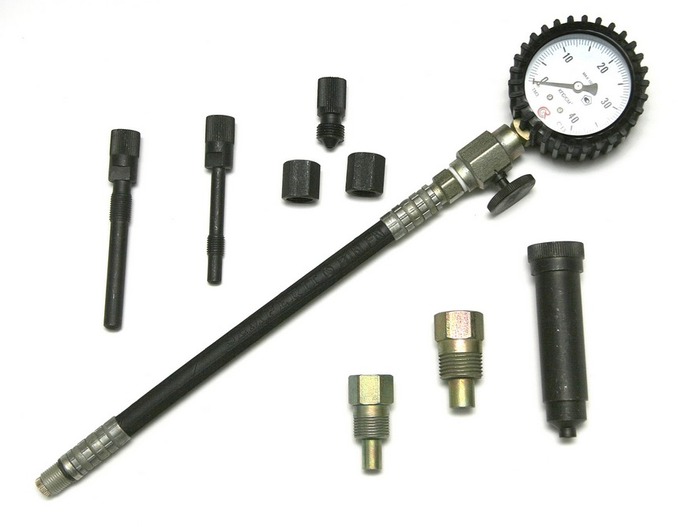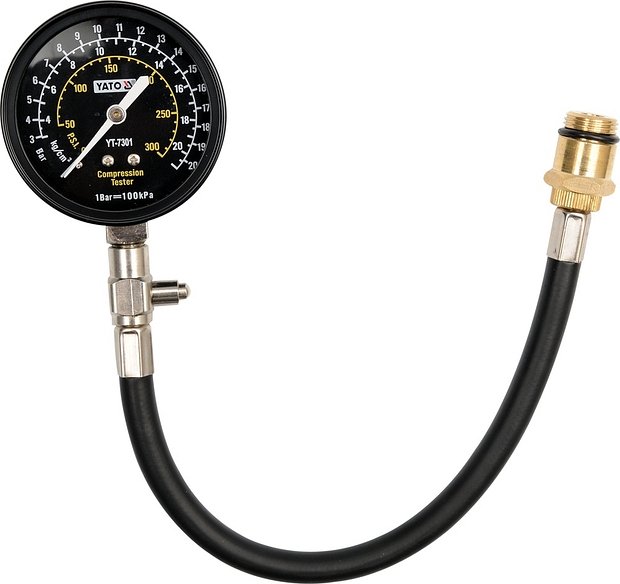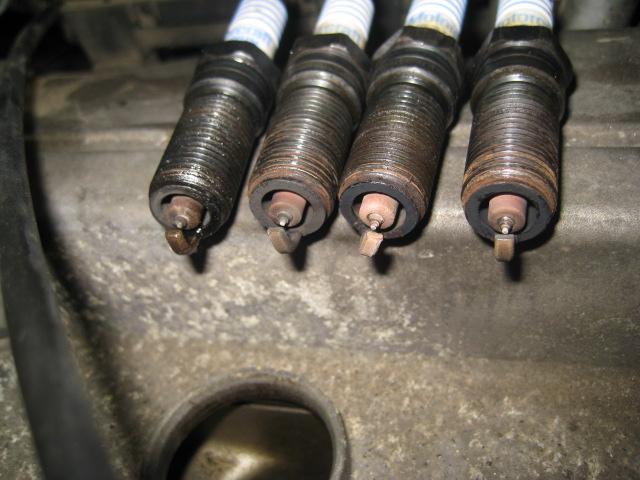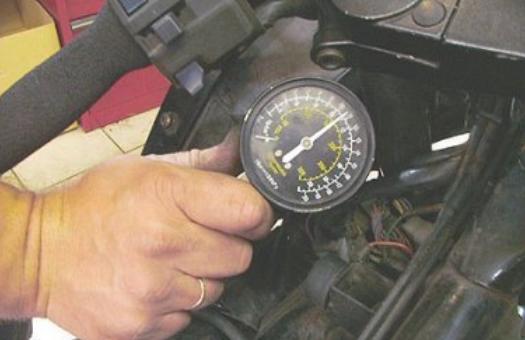If the engine "eats" a lot of oil starts to stroke unknown why, idling does not work well if power drops - you need to check the compression of your car cylinders.
Bad engine cylinder compression is the cause of the above problems. And in order to properly test the car, you need to know the compression of the engine of your car. And how to measure the compression of your car, we will tell in this article.
Content
Compressometer - Assistant in determining the engine compression
Initially, we need to know what compression is.
Compression, there is nothing more than a compressed air pressure in each cylinder of your car at the lowest compression moment - in this case, the pressure in the cylinder will be maximal.

With the proper operation of the car, the compression in all cylinders should be the same.
We are faced with the task to measure the maximum pressure in each cylinder in turn.
During the measurement of compression, the engine engine will rotate from the starter using the battery.
To measure compression, it is necessary to purchase a compressometer.

It can be borrowed from anyone else, or buy in a car shop, since its price is small.
Choosing a compressometer in the auto shop, pay attention to the tip - it should be screwed into the candle channel, it is necessary that the tip and pressure gauge are interconnected by a flexible hose.
Flexible hose unlike the tube facilitates work.
Pay attention to the scale of maximum pressure, it must be at least 20 kg / cm2.

To measure compression, in addition to the compressometer, a candle wrench is required and an assistant that will turn on the car using the ignition key.
Check the status of the battery of your machine and the serviceability of the starter, since when measuring the compression it will take a certain load on these mechanisms.
Step-by-step instruction for measuring a car compression
For accurate measurement of compression, you need to do the following:
- run the engine, let it work for a while. When the engine reaches the engine 90 degrees - muffle the machine;
- make each wire to the ignition and the candle with the marker or marker, different colors (so as not to confuse the wires when connected). Now remove the wires from all the spark plugs;
- disconnect the gas station from the engine;
- around the spark plugs, wipe the surface from dirt and unscrew the candles;

- relieve the testimony on the compressometer to 0, using the pressure reset valve;
- screw the compressometer into the first candle hole;
- give the command to the assistant to put pressure on the gas pedal to the end and turn the starter using the ignition key for 6-10 seconds. At the end of this operation, the compressometer will be recorded maximum pressure - write it down;

- stop starter operation. At the same time it is necessary to damage the time until maximum pressure in seconds;
- in the same way, check the operation of all cylinders, do not forget to fix the time and maximum pressure. Check with the data of the compression of your car by passport. A normal indicator for gasoline engines is considered to be the pressure of 10-12 kg / cm2.
Disappeared compression in the cylinder of the car, what to do?
If you have made the compression of your cylinders and the results of disappointing - it is necessary to carry out additional tests.
You should find out why the level of compression has dropped, and it can be reduced by the wear of the piston rings, or due to the presence of slots and holes in the cylinder.
It is necessary to make the following actions:
- take a tablespoon and pour clean engine oil into it;
- pour this oil into the cylinder into a suspicious cylinder;
- connect the compressometer to it and re-measure compression;
- if the pressure increases in the engine - then the piston rings are worn out and you are a direct road to the auto repair shop;
- if the testimony on the manometer has not changed - most likely the engine valves or bad gaskets work well. Independently check the operation of the valves is not easy and the proceeding gasket is hard to determine hard - we are going to work in the workshop.
Removation of compression and possible engine malfunctions
If we have compression from 12 to 15 kg / cm2, and the exhaust gases of a bluette color, the car actively "eats" the oil is most likely the oil-leaf caps are most likely and a nagar was formed in the combustion chamber.
If the compression is below the norm, from 6.5 to 9.5 kg / cm2, and the exhaust gases of the bluette color, the machine actively "eats" the oil - most likely wear out of the piston (oil-leather) rings or the pistons themselves, may be damaged on the cylinder walls.
When compression testimony from 7 to 8.5 kg / cm2 and the cylinder does not work - most likely damaged camshaft camshafts.
With compression from 6 to 8 kg / cm2 and exhaust gases of bluish color, with increased oil consumption, as well as when the oil pressure increases, the crack appeared on the piston jumper.
When compression from 5 to 8 kg / cm2 and, if completely or partially, there was a refusal to work in the cylinder - the valve is not returned to its original position.
When compression from 4.5 to 6 kg / cm2 and if the engine at idle turns is unstable, and the oil consumption increased - perhaps the piston overheats and burned.
Related Materials
- Stove 2110, bad warm stove 2110, VAZ 2110 heating system, repairing the heating system VAZ 2110 with their own hands
- VAZ 2114 stove blows with cold air, stove 2114, bad warm stove VAZ 2114, device and repair of heating VAZ 2114 do-it-yourself, removing the stove VAZ 2114
- How to subdominize the car. How to put a jack. Types of jacks for cars.
- VAZ 2109 Fuse Block, VAZ 2109 Fuse Block Carburetor, VAZ 2109 Fuse Block Injector, Old VAZ 2109 Fuse Block, VAZ 2109 Fuse Block, VAZ Fuse Block 2109
- Car exhaust gas catalyst, faulty catalyst, pluses and cons of the catalyst, how to change the catalyst on the planeencitel
- Stove blowing cold air VAZ 2114, badly blowing the stove VAZ 2114, why badly blowing the stove VAZ 2114
- How to find out the owner of the car by the number of his car, check the car by the number of the traffic police machine, check the car by the state number of the car for free
- How to choose Used tires, Useful Tips
- Winter car road, pressure in passenger car tires in winter, good battery for the car in winter, whether to warm the car in winter
- In winter, the car is poorly started. How to make a car in winter, do you need to warm up the car in winter, useful tips
- Economy fuel consumption machines, the most economical car consumption
- Tires brands for passenger cars, labeling of car tire labeling, residual passenger car tire protector, how to pick a tire on a car brand, car tire tread pattern
- Working transmission operation, mechanical gearbox clutch work, driving with manual gearbox, useful tips
- Rear beam Peugeot 206 sedan, rear beam device Peugeot 206. Rear beam Peugeot 206 Malfunction, repair of the rear beam Peugeot 206
- Diesel fuel in winter, additive for diesel fuel in winter, how to choose the best diesel fuel
- Diesel winter does not start. How to start diesel in winter, heating diesel in winter.
- Japanese bridgestone tires, winter studded bridgestone tires, bridgestone tires brand
- Tire marking decoding for passenger cars, labeling wheels, how to choose the right tires on the disks
- Diesel engine in winter, launch of the diesel engine in winter, what oil to fill in a diesel engine in winter, useful tips
- LED backlight of the car, the backlight of the bottom of the car, the backlight of the legs in the car, the backlight in the door of the car, the backlight of the car is fine
- Recovered tires, bus tire, restored tire protector, can I use them
- Choose winter tires, which is a winter tires, which pressure in winter tires should be marked with winter tires, how to choose the right winter tires, the best winter tires 2019
- Steering rail rail, knock of steering rack, reasons for the knock and repair of the steering rack do it yourself
- Cameless car tires, a set for repair of tubeless tires, repair of the cannon-free tire do it yourself
- Russian tires, Russian tires Winter, Russian All-season tires, Voronezh AMTEL tires, Tires "Matador Omsk Tire", Kama-tires are world-class bus
- How to open a car without a key. Lost the key from the car what to do, the key from the car inside the car
- Silent tires, quiet winter tires, quiet studded bus, which tires to choose, overview tires
- Tires and safety, safety of the bus, why it is necessary to constantly monitor car tires
- Rules of safe driving of the car in the rain and slush, safe driving of the car for beginners
- Rust converter which is better for cars, rust converters to choose how to use rust transducer, professionals
- Polishing the body of the car do it yourself, how to choose a polishing paste, useful tips
- Engine durability, engine life, how to extend engine life
- Knock in the car. Knock when moving the car. What can knock in the car. How to determine the cause of the knock.
- ABS car, what is ABS car, ABS system malfunction, ABS diagnostics
- Overtaking a car when you can start overtaking a car, rules of traffic rules
- Fuel pump VAZ 2110, VAZ 2110 gas station scheme, VAZ 2110 fuel pump device, VAZ 2110 gas station repair,
- Automotive antennas for radio, automotive antenna device, car antenna do it yourself
- Front suspension Kalina, device front suspension Kalina, knock in front suspension Kalina, repair of front suspension Kalina
- Shock absorber Oil, best oil shock absorbers, pumping oil shock absorbers, how to properly pump oil shock absorber
- Clutch malfunctions, touches clutch, causes a clutch malfunction, how to eliminate







Comments